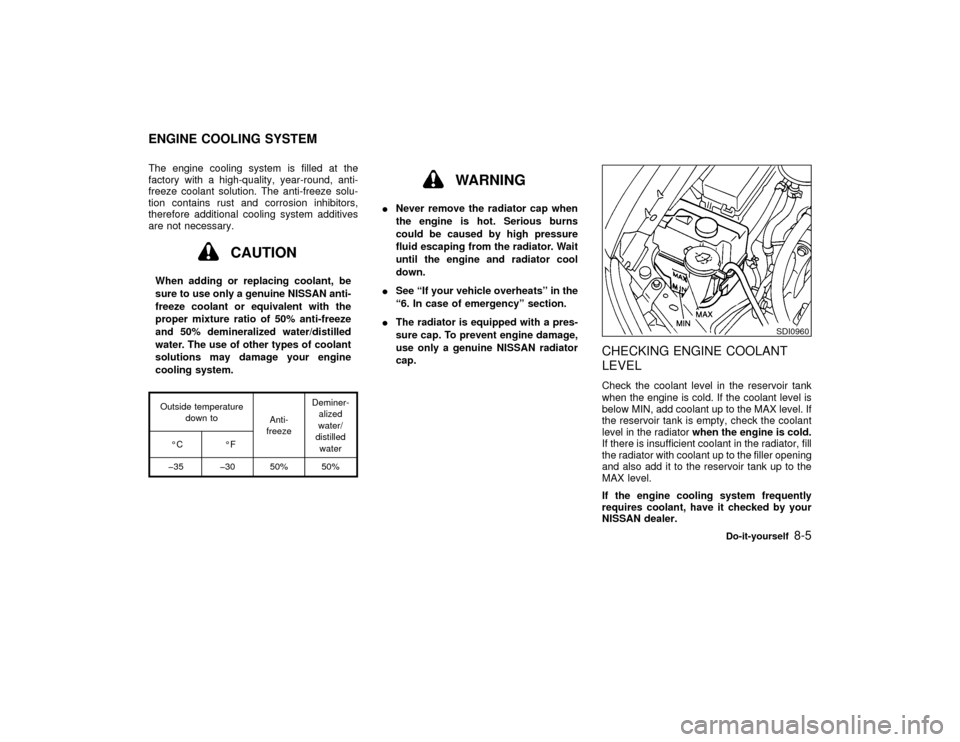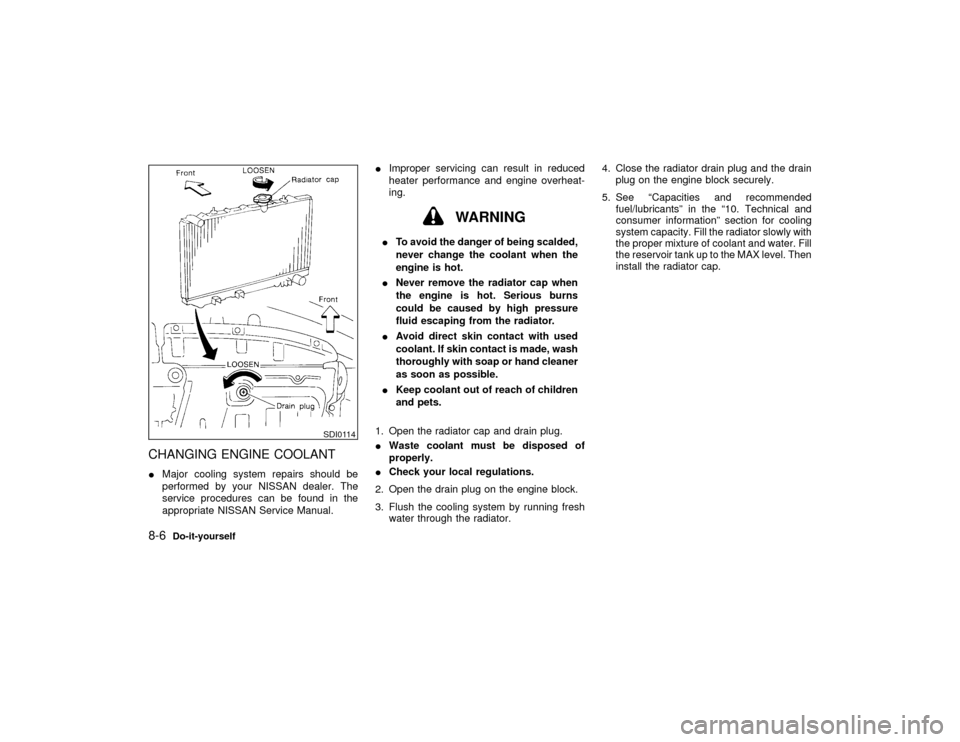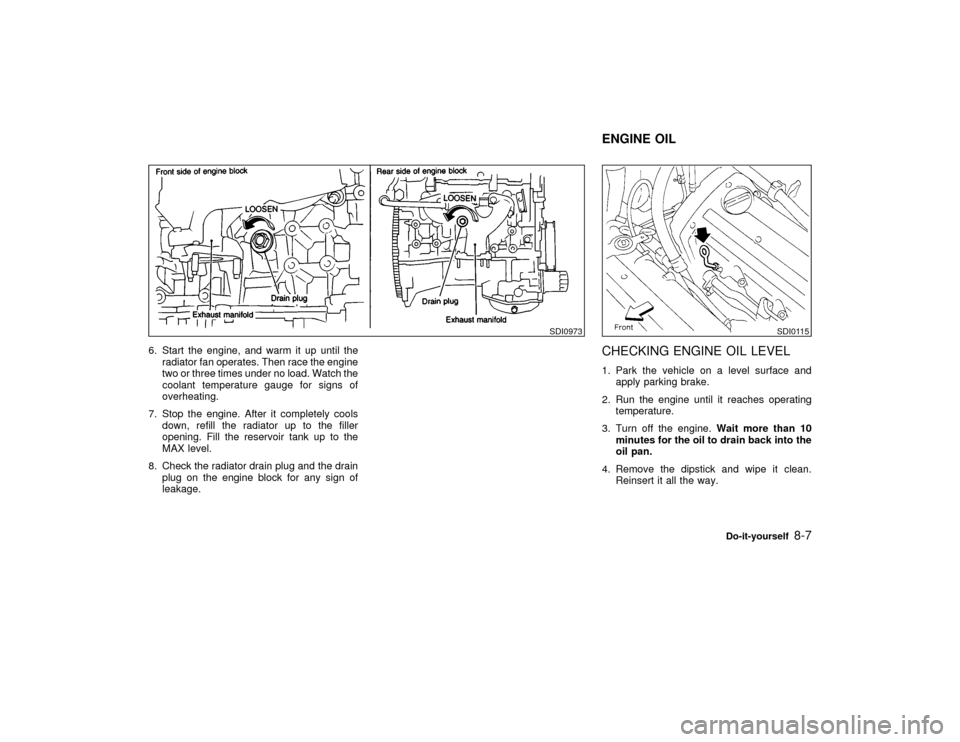2001 NISSAN MAXIMA engine overheat
[x] Cancel search: engine overheatPage 174 of 247

The engine cooling system is filled at the
factory with a high-quality, year-round, anti-
freeze coolant solution. The anti-freeze solu-
tion contains rust and corrosion inhibitors,
therefore additional cooling system additives
are not necessary.
CAUTION
When adding or replacing coolant, be
sure to use only a genuine NISSAN anti-
freeze coolant or equivalent with the
proper mixture ratio of 50% anti-freeze
and 50% demineralized water/distilled
water. The use of other types of coolant
solutions may damage your engine
cooling system.Outside temperature
down to
Anti-
freezeDeminer-
alized
water/
distilled
water ÉC ÉF
þ35 þ30 50% 50%
WARNING
INever remove the radiator cap when
the engine is hot. Serious burns
could be caused by high pressure
fluid escaping from the radiator. Wait
until the engine and radiator cool
down.
ISee ªIf your vehicle overheatsº in the
ª6. In case of emergencyº section.
IThe radiator is equipped with a pres-
sure cap. To prevent engine damage,
use only a genuine NISSAN radiator
cap.
CHECKING ENGINE COOLANT
LEVELCheck the coolant level in the reservoir tank
when the engine is cold. If the coolant level is
below MIN, add coolant up to the MAX level. If
the reservoir tank is empty, check the coolant
level in the radiatorwhen the engine is cold.
If there is insufficient coolant in the radiator, fill
the radiator with coolant up to the filler opening
and also add it to the reservoir tank up to the
MAX level.
If the engine cooling system frequently
requires coolant, have it checked by your
NISSAN dealer.
SDI0960
ENGINE COOLING SYSTEM
Do-it-yourself
8-5
Z
00.1.17/A33-D/V5.0
X
Page 175 of 247

CHANGING ENGINE COOLANTIMajor cooling system repairs should be
performed by your NISSAN dealer. The
service procedures can be found in the
appropriate NISSAN Service Manual.IImproper servicing can result in reduced
heater performance and engine overheat-
ing.
WARNING
ITo avoid the danger of being scalded,
never change the coolant when the
engine is hot.
INever remove the radiator cap when
the engine is hot. Serious burns
could be caused by high pressure
fluid escaping from the radiator.
IAvoid direct skin contact with used
coolant. If skin contact is made, wash
thoroughly with soap or hand cleaner
as soon as possible.
IKeep coolant out of reach of children
and pets.
1. Open the radiator cap and drain plug.
IWaste coolant must be disposed of
properly.
ICheck your local regulations.
2. Open the drain plug on the engine block.
3. Flush the cooling system by running fresh
water through the radiator.4. Close the radiator drain plug and the drain
plug on the engine block securely.
5. See ªCapacities and recommended
fuel/lubricantsº in the ª10. Technical and
consumer informationº section for cooling
system capacity. Fill the radiator slowly with
the proper mixture of coolant and water. Fill
the reservoir tank up to the MAX level. Then
install the radiator cap.
SDI0114
8-6
Do-it-yourself
Z
00.1.17/A33-D/V5.0
X
Page 176 of 247

6. Start the engine, and warm it up until the
radiator fan operates. Then race the engine
two or three times under no load. Watch the
coolant temperature gauge for signs of
overheating.
7. Stop the engine. After it completely cools
down, refill the radiator up to the filler
opening. Fill the reservoir tank up to the
MAX level.
8. Check the radiator drain plug and the drain
plug on the engine block for any sign of
leakage.
CHECKING ENGINE OIL LEVEL1. Park the vehicle on a level surface and
apply parking brake.
2. Run the engine until it reaches operating
temperature.
3. Turn off the engine.Wait more than 10
minutes for the oil to drain back into the
oil pan.
4. Remove the dipstick and wipe it clean.
Reinsert it all the way.
SDI0973
SDI0115
ENGINE OIL
Do-it-yourself
8-7
Z
00.1.17/A33-D/V5.0
X
Page 219 of 247

Octane rating tipsIn most parts of North America, you should use
unleaded gasoline with an octane rating of at
least 87 or 91 AKI (Anti-Knock Index) number.
However, you may use unleaded gasoline with
an octane rating as low as 85 AKI number in
these high altitude areas [over 4,000 ft (1,219
m)] such as: Colorado, Montana, New Mexico,
Utah, Wyoming, northeastern Nevada, south-
ern Idaho, western South Dakota, western
Nebraska, and that part of Texas which is
directly south of New Mexico.
Using unleaded gasoline with an octane
rating lower than stated above can cause
persistent, heavy spark knock. (Spark
knock is a metallic rapping noise.) If se-
vere, this can lead to engine damage. If you
detect a persistent heavy spark knock even
when using gasoline of the stated octane
rating, or if you hear steady spark knock
while holding a steady speed on level
roads, have your dealer correct the condi-
tion. Failure to correct the condition is
misuse of the vehicle, for which NISSAN is
not responsible.
Incorrect ignition timing will result in knocking,
after-run or overheating. This in turn may
cause excessive fuel consumption or damage
to the engine. If any of the above symptomsare encountered, have your vehicle checked at
a NISSAN dealer or other competent service
facility.
However, now and then you may notice
light spark knock for a short time while
accelerating or driving up hills. This is no
cause for concern, because you get the
greatest fuel benefit when there is light
spark knock for a short time under heavy
engine load.10-4
Technical and consumer information
Z
00.1.17/A33-D/V5.0
X
Page 233 of 247

trailer is hitched. Do not drive the vehicle if
it has an abnormal nose-up or nose-down
condition; check for improper tongue load,
overload, worn suspension or other pos-
sible causes of either condition.
IAlways secure items in the trailer to prevent
load shifts while driving.
IBe certain your rear view mirrors conform to
all federal, state or local regulations. If not,
install any mirrors required for towing be-
fore driving the vehicle.
Trailer towing tipsIn order to gain skill and an understanding of
the vehicle's behavior, you should practice
turning, stopping and backing up in an area
which is free from traffic. Steering stability, and
braking performance will be somewhat differ-
ent than under normal driving conditions.
IAlways secure items in the trailer to prevent
load shift while driving.
IAvoid abrupt starts, acceleration or stops.
IAvoid sharp turns or lane changes.
IAlways drive your vehicle at a moderate
speed.
IAlways block the wheels on both vehicle
and trailer when parking. Parking on aslope is not recommended; however, if you
must do so, and if your vehicle is equipped
with automatic transmission, first block the
wheels and apply the parking brake, and
then move the transmission selector lever
into the P (Park) position. If you move the
selector lever to the P (Park) position be-
fore blocking the wheels and applying the
parking brake, transmission damage could
occur.
IWhen going down a hill, shift into a lower
gear and use the engine braking effect.
When ascending a long grade, downshift
the transmission to a lower gear and reduce
speed to reduce chances of engine over-
loading and/or overheating.
IIf the engine coolant rises to an extremely
high temperature when the air conditioning
system is on, turn off the air conditioner.
Coolant heat can be additionally vented by
opening the windows, switching the fan
control to high and setting the temperature
control to the HOT position.
ITrailer towing requires more fuel than nor-
mal circumstances.
IAvoid towing a trailer for the first 500 miles
(800 km).
IHave your vehicle serviced more often thanat intervals specified in the recommended
maintenance schedule.
IWhen making a turn, your trailer wheels will
be closer to the inside of the turn than your
vehicle wheels. To compensate for this,
make a larger than normal turning radius
during the turn.
ICrosswinds and rough roads will adversely
affect vehicle/trailer handling, possibly
causing vehicle sway. When being passed
by larger vehicles, be prepared for possible
changes in crosswinds that could affect
vehicle handling. If swaying does occur,
firmly grip the steering wheel, steer straight
ahead, and immediately (but gradually) re-
duce vehicle speed. This combination will
help stabilize the vehicle. Never increase
speed.
IBe careful when passing other vehicles.
Passing while towing a trailer requires con-
siderably more distance than normal pass-
ing. Remember the length of the trailer
must also pass the other vehicle before you
can safely change lanes.
ITo maintain engine braking efficiency and
electrical charging performance, do not use
fifth gear (manual transmission) or over-
drive (automatic transmission).10-18
Technical and consumer information
Z
00.1.17/A33-D/V5.0
X
Page 241 of 247

Top tether strap anchor point locations .... 1-36
With top tether strap.................................. 1-36
Child safety ..................................................... 1-23
Child safety rear door lock................................ 3-4
Chimes ............................................................ 2-11
Circuit breaker, Fusible link ............................ 8-21
Cleaning exterior and interior .................... 7-2, 7-4
Clock ............................................................... 2-29
Clutch
Clutch pedal .............................................. 8-19
Fluid ........................................................... 8-12
Cold weather driving ....................................... 5-21
Compact Disc (CD) player (See audio
system) ........................................................... 4-22
Compact disc (CD) player operation .............. 4-12
Compact spare tire ......................................... 8-33
Console box .................................................... 2-25
Controls
Audio controls............................................ 4-12
Audio controls (rear).................................. 4-12
Audio controls (steering wheel)................. 4-12
Heater and air conditioner controls ............. 4-3
Heater and semiautomatic air
conditioner ................................................... 4-3
Coolant
Capacities and recommended fuel/
lubricants ................................................... 10-2
Changing engine coolant ............................ 8-6
Checking engine coolant level .................... 8-5
Corrosion protection ......................................... 7-5
Cruise control.................................................. 5-13
Cup holder ...................................................... 2-23D
Daytime running light system ......................... 2-18
Defogger switch, Rear window and outside mirror
defogger switch............................................... 2-15
Dimensions and weights ................................. 10-9
Door open warning light ................................... 2-8
Drive belts ....................................................... 8-15
Driving
Cold weather driving ................................. 5-21
Driving with automatic transmission............ 5-8
Driving with manual transmission ............. 5-11
Precautions when starting and driving ........ 5-2
E
Economy, Fuel ................................................ 5-16
Emission control information label ................ 10-11
Emission control system warranty ................ 10-20
Engine
Before starting the engine ........................... 5-7
Block heater .............................................. 5-22
Capacities and recommended fuel/
lubricants ................................................... 10-2
Changing engine coolant ............................ 8-6
Changing engine oil .................................... 8-8
Changing engine oil filter ............................ 8-9
Checking engine coolant level .................... 8-5
Checking engine oil level ............................ 8-7
Coolant temperature gauge ........................ 2-5
Engine compartment check locations ......... 8-4
Engine cooling system ................................ 8-5
Engine oil..................................................... 8-7Engine oil and oil filter recommendation... 10-5
Engine oil viscosity .................................... 10-5
Engine serial number .............................. 10-11
Engine specifications................................. 10-7
If your engine overheats ........................... 6-10
Starting the engine ...................................... 5-7
Exhaust gas (Carbon monoxide) ...................... 5-2
F
F.M.V.S.S. certification label......................... 10-11
Filter, Air cleaner housing filter ....................... 8-16
Flashers (See hazard warning flasher
switch) ............................................................. 2-19
Flat tire .............................................................. 6-2
Floor mat cleaning ............................................ 7-4
Fluid
Automatic transmission fluid (ATF) ........... 8-10
Brake and clutch fluid................................ 8-12
Capacities and recommended fuel/
lubricants ................................................... 10-2
Engine coolant............................................. 8-5
Engine oil..................................................... 8-7
Power steering fluid................................... 8-11
Window washer fluid ................................. 8-12
Folding rear seat............................................... 1-6
Front air bag system (See supplemental restraint
system) ........................................................... 1-14
Front manual seat adjustment .......................... 1-2
Front power seat adjustment ............................ 1-4
Fuel
Capacities and recommended fuel/
lubricants ................................................... 10-2
Filler cap .................................................... 3-12
Z
00.1.17/A33-D/V5.0
X
11-2
Page 243 of 247

Warning/indicator lights and chimes .... 2-7, 2-9
Lights, Exterior and interior light
replacement .................................................... 8-25
Loading information (See vehicle loading
information) ................................................... 10-14
Lock
Door locks ................................................... 3-3
Glove box lock........................................... 2-24
Power door lock .......................................... 3-3
Trunk lid lock opener lever........................ 3-10
Low fuel warning light ....................................... 2-9
M
Maintenance
Battery ....................................................... 8-13
Explanation of maintenance items..... 9-3, 9-10
General maintenance........................... 9-2, 9-3
Inside the vehicle ................................. 9-2, 9-3
Maintenance precautions ............................ 8-2
Outside the vehicle .............................. 9-2, 9-3
Periodic maintenance schedules ................ 9-5
Seat belt maintenance .............................. 1-27
Manual front seat adjustment ........................... 1-2
Meters and gauges ........................................... 2-3
Mirror
Inside mirror .............................................. 3-14
Outside mirror............................................ 3-15
Outside mirror control................................ 3-15
Outside mirrors .......................................... 3-15
Multi-remote control system.............................. 3-4N
Net, Cargo net ................................................ 2-25
New vehicle break-in ...................................... 5-15
Nissan Vehicle immobilizer system ................ 2-12
Nissan Vehicle Immobilizer System, Engine
start ................................................................... 5-6
O
Odometer .......................................................... 2-4
Oil
Capacities and recommended fuel/
lubricants ................................................... 10-2
Changing engine oil .................................... 8-8
Changing engine oil filter ............................ 8-9
Checking engine oil level ............................ 8-7
Engine oil..................................................... 8-7
Engine oil viscosity .................................... 10-5
Outside mirror ................................................. 3-15
Outside mirror control ..................................... 3-15
Outside mirrors ............................................... 3-15
Overdrive switch ............................................. 5-10
Overheat, If your vehicle overheats................ 6-10
P
Parking
Brake check............................................... 8-18
Parking brake check.................................. 5-13
Parking brake operation ............................ 5-13
Parking on hills .......................................... 5-13
Parking/parking on hills .................................. 5-17Periodic maintenance schedules ...................... 9-5
Personal light .................................................. 2-30
Power
Front seat adjustment ................................. 1-4
Power door lock .......................................... 3-3
Power outlet .............................................. 2-21
Power steering fluid................................... 8-11
Power steering system .............................. 5-18
Power windows ......................................... 2-26
Pre-tensioner seat belt system ....................... 1-17
Precautions
Braking precautions................................... 5-18
Cruise control precautions ........................ 5-14
Maintenance precautions ............................ 8-2
On child restraints ..................................... 1-28
On seat belt usage .................................... 1-21
On supplemental restraint system .............. 1-9
Precautions when starting and driving ........ 5-2
Push starting ..................................................... 6-9
R
Radio, Car phone or CB radio ........................ 4-25
Readiness for inspection/maintenance (I/M) test
(US only) ....................................................... 10-21
Rear door lock, Child safety rear door lock...... 3-4
Rear power point ............................................ 2-21
Rear window and outside mirror defogger
switch .............................................................. 2-15
Registering your vehicle in another
country .......................................................... 10-10
Remote keyless entry, (See multi-remote control
system) ............................................................. 3-4
Reporting safety defects (US only)............... 10-20
Z
00.1.17/A33-D/V5.0
X
11-4